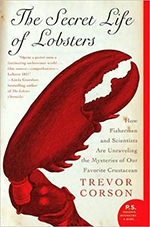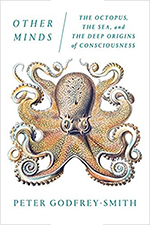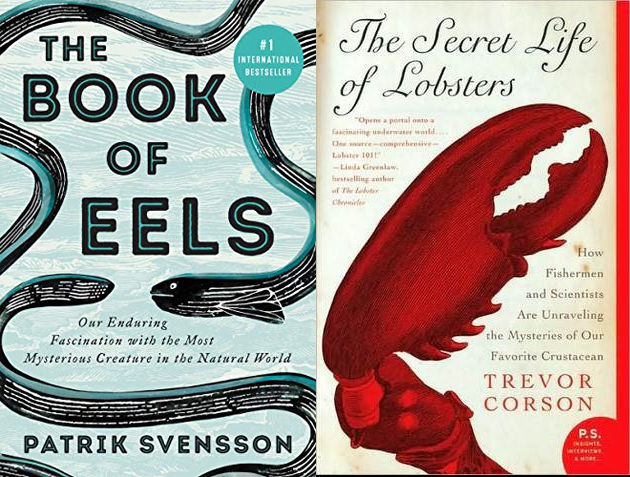I recently finished two books that feel “of a piece.” Here is a combined review, and I’ve thrown in a review of a similar book too, as a lagniappe.
The Book of Eels, by Patrik Svensson
 This new book recounts the amazingly hidden world of the European eel, with digressions into American eels and Japanese eels. It alternates chapters focused on science and the history of that science with chapters of reminiscence, where the author recounts eel fishing with his father, and ties the history of his family in Sweden with key aspects of eel biology. It’s a personal memoir about his father, and at times it seems like Svensson is losing the thread with too much family focus, but eventually it always loops back around to the mystery of the eel. And they are mysterious indeed. The animal goes through four metamorphoses during its life, after being born in the Sargasso Sea, then finding its way to Europe across the wide Atlantic, working its way up a freshwater stream, and establishing itself inland for years, perhaps decades, and in several cases, for probably more than a century, before returning to the sea and spawning. These different body plans are so distinct that for a while, they were thought to be separate species. A fun chapter in the book recounts young Sigmund Freud’s fruitless summer of dissecting eels in Trieste, searching for the testicles of one of the pre-reproductive life stages. Another fascinating chapter recalls the heroic decades-long effort by Johannes Schmidt to trace leptocephalus eel larvae to their source, scouring the ocean for smaller and smaller specimens. It was because of this work that biologists have come to the conclusion that the Sargasso Sea is the birthplace of the eel. But no one has ever observed adult reproductive eels in the Sargasso Sea. Never, not alive or dead. Do they actually spawn there? No one has every actually observed eels spawning at all. This is part of the mystery. It’s compounded by the eels’ decreasing numbers. In half a century, they have gone from a reasonably common foodstuff to a critically endangered species.
This new book recounts the amazingly hidden world of the European eel, with digressions into American eels and Japanese eels. It alternates chapters focused on science and the history of that science with chapters of reminiscence, where the author recounts eel fishing with his father, and ties the history of his family in Sweden with key aspects of eel biology. It’s a personal memoir about his father, and at times it seems like Svensson is losing the thread with too much family focus, but eventually it always loops back around to the mystery of the eel. And they are mysterious indeed. The animal goes through four metamorphoses during its life, after being born in the Sargasso Sea, then finding its way to Europe across the wide Atlantic, working its way up a freshwater stream, and establishing itself inland for years, perhaps decades, and in several cases, for probably more than a century, before returning to the sea and spawning. These different body plans are so distinct that for a while, they were thought to be separate species. A fun chapter in the book recounts young Sigmund Freud’s fruitless summer of dissecting eels in Trieste, searching for the testicles of one of the pre-reproductive life stages. Another fascinating chapter recalls the heroic decades-long effort by Johannes Schmidt to trace leptocephalus eel larvae to their source, scouring the ocean for smaller and smaller specimens. It was because of this work that biologists have come to the conclusion that the Sargasso Sea is the birthplace of the eel. But no one has ever observed adult reproductive eels in the Sargasso Sea. Never, not alive or dead. Do they actually spawn there? No one has every actually observed eels spawning at all. This is part of the mystery. It’s compounded by the eels’ decreasing numbers. In half a century, they have gone from a reasonably common foodstuff to a critically endangered species.
The Secret Life of Lobsters, by Trevor Corson

Speaking of animals we eat, consider the lobster. Trevor Corson did, in this 2005 book. As with The Book of Eels, Corson’s book combines personal history with the story of scientific insights about the lobster in the Gulf of Maine. Corson gives equal weight to the stories of lobstermen and biologists, describing the arcs of their lives as well as the insights they generate about the behavior of the chunky crustaceans. My favorite story is that of Diane Cowan, who was so lobster obsessed as a young scientist that she took a lobster experimentalist job without pay or a place to live, just so she could focus her attention on lobsters as much as possible. Her experiments with captive lobsters in tanks revealed key information about the way lobsters mate and balance their social lives. She eventually landed the job of chief lobster biologist for the state of Maine, but quit because she found it didn’t provide her enough time with lobsters! Both Corson and Svensson tell the stories of their scientist subjects well, but Corson’s book comes away feeling more person-focused, while Svensson’s attention is wonder-focused on the eels.
These two books reminded my of a worthy third, which I recently re-read. So I republish here my review of that volume, on octopuses, for the sake of rounding out a trilogy of watery animal profiles:
Other Minds, by Peter Godfrey-Smith
 The Octopus, the Sea, and the Deep Origins of Consciousness is the subtitle of this fascinating, extremely approachable book. Paraphrasing Thomas Nagle, it asks “What is it like to be an octopus?” The author is a philosopher by training, but he does a fantastic job as a science writer, too. Anecdotes about encounters with cephalopods while diving are mixed with careful, deliberate, dejargonized descriptions of the scientific studies that have illuminated the evolution of minds. While we know that dolphins and chimpanzees and parrots are smart, they are all united in being vertebrates with a similarly-organized nervous system. Cuttlefish, squid, and octopuses are however much more distantly related (we share a common ancestor something like 550-600 million years ago), and yet they have independently evolved a remarkable intelligence. Like us, they have large nervous system and camera-like eyes, and they play, solve puzzles, and are able to recognize specific individuals (both among octopuses and humans). Unlike us, they have almost no skeletal material, most of their neurons are in their tentacles (essentially, “eight large, flexible lips”), and what amounts to a brain is roughly donut-shaped and has their digestive system pass straight through its middle! They are weird – as alien a natural being as we are likely to ever encounter.
The Octopus, the Sea, and the Deep Origins of Consciousness is the subtitle of this fascinating, extremely approachable book. Paraphrasing Thomas Nagle, it asks “What is it like to be an octopus?” The author is a philosopher by training, but he does a fantastic job as a science writer, too. Anecdotes about encounters with cephalopods while diving are mixed with careful, deliberate, dejargonized descriptions of the scientific studies that have illuminated the evolution of minds. While we know that dolphins and chimpanzees and parrots are smart, they are all united in being vertebrates with a similarly-organized nervous system. Cuttlefish, squid, and octopuses are however much more distantly related (we share a common ancestor something like 550-600 million years ago), and yet they have independently evolved a remarkable intelligence. Like us, they have large nervous system and camera-like eyes, and they play, solve puzzles, and are able to recognize specific individuals (both among octopuses and humans). Unlike us, they have almost no skeletal material, most of their neurons are in their tentacles (essentially, “eight large, flexible lips”), and what amounts to a brain is roughly donut-shaped and has their digestive system pass straight through its middle! They are weird – as alien a natural being as we are likely to ever encounter.
Godfrey-Smith describes the evolution of minds from the very earliest signalling behavior in bacteria, drawing from molecular genetics, developmental biology, ethology, and paleontology. He spends a delicious chapter among the Ediacara fauna en route. In plain terms, he illuminates what a nervous system is good for. He reveals that which is hiding in plain sight: that our nervous systems can partially operate independently of direction from our brains, and argues that octopus tentacles may well be said to “think” for themselves. He dives deep into the remarkable color/texture manipulation of the skin in these cephalopods, and the evolutionary pressures that led to their woefully short lifespans (most octopuses are dead by two years of age). He explores the possible beginnings of octopus culture at a site off the coast of Australia, and speculates how unusual social living might drive octopus mind evolution in new directions. All told, I found it to be a heartfelt, insightful book.

